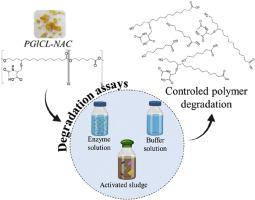Polymer Degradation and Stability ( IF 6.3 ) Pub Date : 2020-07-01 , DOI: 10.1016/j.polymdegradstab.2020.109287 Camila Guindani , Graziâni Candiotto , Pedro H.H. Araújo , Sandra R.S. Ferreira , Débora de Oliveira , Frederik R. Wurm , Katharina Landfester

|
Controlling the degradation rates of polymers is crucial for their application in tissue engineering or to achieve degradation of the polymers in the wastewater purification. As hydrophobic polyesters often exhibit very slow degradation rates, we report here increased biodegradation rates of poly(globalide-co-ε-caprolactone) copolymers (PGlCL) produced by enzymatic ring-opening copolymerization and post-functionalized with N-acetylcysteine by thiol-ene reaction. The degradation rates of the PGlCL and post-modified PGlCL-NAC films were determined by weight-loss experiments. The polymer films were immersed in phosphate-buffered saline (PBS) solution, and PBS containing lipase from Pseudomonas cepacia. The degree of functionalization affected the degradation behavior, and samples with a higher degree of functionalization presented higher weight loss. Finally, a degradation assay was performed in activated sludge, and PGlCL-NAC presented high degradability, having a degradation behavior similar to starch. Density Functional Theory (DFT) calculations were used to assess the changes in chemical properties and electronic charge distribution of PGlCL after its functionalization with NAC, helping to understand its influence in their degradability. The results obtained confirm the possibility to increase the degradation rates of copolyesters based on caprolactone and globalide by thiol-ene post-functionalization, being a promising alternative for applications in biomedicine or the packaging sector.
中文翻译:

通过聚合后改性控制聚(Globalide-co-ε-己内酯)共聚物的生物降解速率
控制聚合物的降解速率对于其在组织工程中的应用或在废水净化中实现聚合物的降解至关重要。由于疏水性聚酯通常表现出非常慢的降解速度,因此我们在此报告了通过酶促开环共聚反应和通过硫醇与N-乙酰半胱氨酸后官能化的聚(全局-共-ε-己内酯)共聚物(PGlCL)的生物降解率提高反应。PG1CL和后改性的PG1CL-NAC膜的降解速率通过减重实验确定。将聚合物膜浸入磷酸盐缓冲盐水(PBS)溶液中,并将含有洋葱假单胞菌脂肪酶的PBS浸入。功能化程度影响降解行为,功能化程度越高的样品失重越大。最后,在活性污泥中进行降解测定,并且PG1CL-NAC具有高降解性,具有类似于淀粉的降解行为。密度泛函理论(DFT)计算用于评估PGlCL在NAC中功能化后化学性质和电子电荷分布的变化,从而有助于了解其降解性能的影响。获得的结果证实了通过硫醇-烯后官能化提高基于己内酯和全球化剂的共聚酯降解速率的可能性,这是在生物医学或包装领域中应用的有希望的替代方案。











































 京公网安备 11010802027423号
京公网安备 11010802027423号